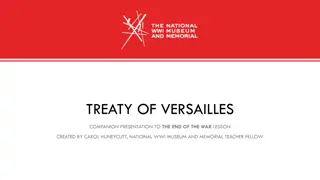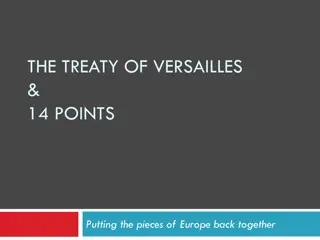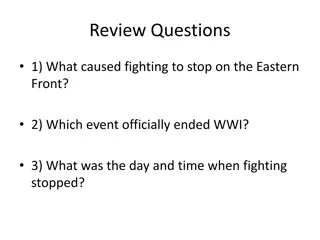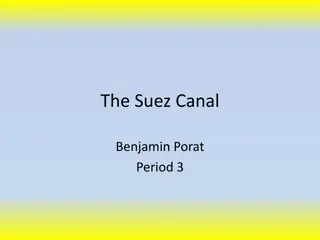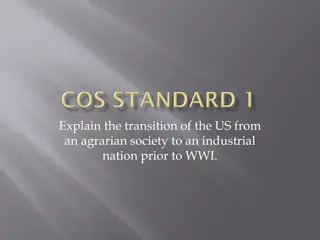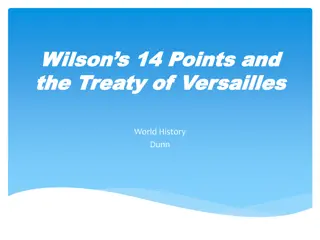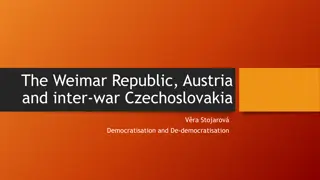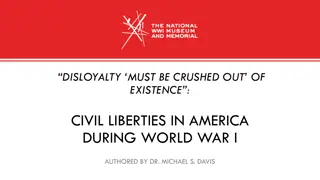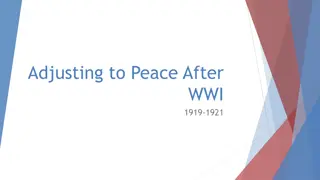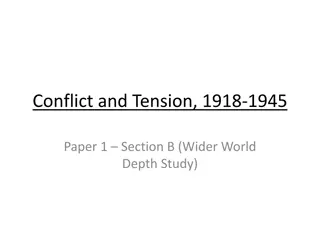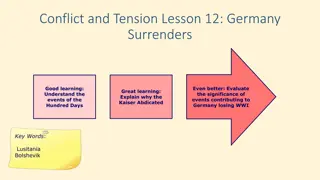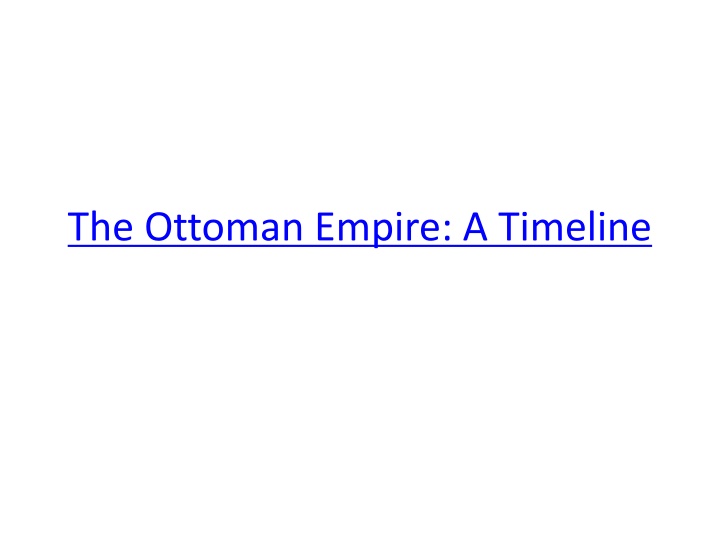
Ottoman Empire: Transformations and Challenges
Explore the Ottoman Empire's transition from the 19th century to modern times through significant events like World War I, political restructuring, and internal upheavals. Witness the empire's struggle for sovereignty and adaptation to changing international dynamics.
Download Presentation

Please find below an Image/Link to download the presentation.
The content on the website is provided AS IS for your information and personal use only. It may not be sold, licensed, or shared on other websites without obtaining consent from the author. If you encounter any issues during the download, it is possible that the publisher has removed the file from their server.
You are allowed to download the files provided on this website for personal or commercial use, subject to the condition that they are used lawfully. All files are the property of their respective owners.
The content on the website is provided AS IS for your information and personal use only. It may not be sold, licensed, or shared on other websites without obtaining consent from the author.
E N D
Presentation Transcript
WWI marks a dramatic division between the 19thcentury and the contemporary age losses in the Ottoman Empire were among the highest of all nations affected by the war: 4 out of 5 Ottoman citizens who died were noncombatants and many of the casualties were a result of famine
WWI brought about a new political order in the region that has lasted to this very day. the creation of the current state system in the region On December 18, 1914, Great Britain unilaterally declared the establishment of a protectorate over Egypt By the early 1920s, Turkey was an independent republic North African provinces had all been occupied Asiatic Arab provinces had been divided into what would become separate states a large part of the Arabian peninsula had been united under the control of the Saudi dynasty A variety of nationalisms --Turkish, Arab, Syrian, Egyptian-- spread throughout the region
Background The Ottoman Empire, a modernizing state in the 19thcentury, sought to establish a sovereign state and to enjoy full membership in the international state system A member of the Concert of Europe since 1856 and the end of the Crimean War Diplomatic, political and political losses since 1878 country in financial ruin and demoralized
In the face of those losses, a radical leadership emerged, organizing itself as the Committee of Union and Progress Belief that only military power could preserve the Empire In the context of the Balkan Wars in 1911-13, the CUP seized control in 1913
The Ottoman government first thought of the War as a European affair The Entente Powers promised the protection of the Ottoman Empire s territorial integrity Promise rejected by the Ottomans: privy to exchanges that indicated otherwise Russian ambassador s note of August 6, 1914: the Ottoman Empire be kept neutral until that point in time when circumstances permit our own firm entrance into the Straits. Biggest Ottoman fear: the European war might precipitate Russian seizure of Istanbul and the Straights
A minority within the CUP hoped for closer ties to France and Russia Majority favored the Triple Alliance CUP proposed alliance with the Central Powers or the Empire would side with the Entente Germans feared loss of investments and of a chance to gain a sphere of dominance in the Near East A German-Ottoman alliance was signed on August 2, 1914 The Ottomans thought of it more as a defensive alliance
A naval attack on Russia, October 27-31, 1914 Precipitation of the Empire s entry into the war Russian retaliation at the Ottoman-Russian borders British and French warships opened fire at Ottoman troops in anakkale south of the Dardanelles and in Aqaba in Jordan
The Battle of Gallipoli: an attempt by the Allied Powers to control the sea route from Europe to Russia A naval attack followed by land invasion on April 1925 Participation of French and British troops and divisions of ANZAC (Australian and New Zealand Army Corps) Fierce Ottoman resistance Lack of Allies knowledge of the terrain of the battle Evacuation in December 1915
Calamities of the War The war known also as The Famine war Devastation in the region 4 out of every 5 Ottoman citizens died as non- combatant In Mount Lebanon: famine killed about half the population Causes: Entente s blockade, snowy winters, locusts, conscription, war requisition, currency devaluation, official inefficiency
Calamities The Ethnic Cleansing of Armenians Between 800-000 and a million and a half Armenians perished The debate over the genocidal aspects surrounding the death of Armenians
In the meantime, the Entente powers began to maneuver to claim the spoils of war in the event of a victory Starting in 1915: negotiations of secret treaties 1915: the Arab revolt The British promised the Emir of Mecca, Sharif Husayn, gold, guns and an independent Arab state in Ottoman territories in return for a revolt against the Ottoman government
Sykes-Picot agreement: secret agreement between France and Britain to divide up most of the Arab Middle East between them the treaty awarded France a large zone of direct control stretching along the Syrian coast from southern Lebanon into Anatolia and a sphere of exclusive indirect influence in the Syrian interior. Britain gained Iraq and a zone from Gaza to Kirkuk In another treaty, Russia was promised the Turkish straits
http://en.wikipedia.org/wiki/Sykes Picot_Agreement#mediaviewer/File:Sykes-Picot.svg
Another pledge but made openly: the Balfour declaration of November 1917 for a national home in Palestine for Jews around the world the Palestinian mandate: was not a distinctive administrative entity during the Ottoman era but was regarded as part of southern Syria and was divided by the late 19thcentury between the provinces of Beirut and Damascus with the special administrative unit of Jerusalem The British capture of Jerusalem in December 1917 detached Palestine from Ottoman rule and led to its being placed under British military occupation from 1917 to 1920 In 1920: Britain was awarded the mandate for Palestine and the military government was replaced by a civilian administration
Paris meeting: creation of the League of Nations with its charter sanctioning French and British designs for the Levant and Mesopotamia => France got the mandate for the territory that now includes Syria and Lebanon while Britain got the mandate for the territory that now includes Israel, the Palestinian Occupied Territories, Jordan and Iraq the inhabitants of the region were never seriously consulted about their future
the mandate system: a thinly disguised imperialism absolute rights of France and Britain over the internal affairs of their mandates, both economically and politically the creation of Iraq by joining three Ottoman provinces: Baghdad, Mosul and Basra creation of Lebanon, what the French thought would be a permanent Christian enclave the Palestine mandate divided Palestine into separate regions, one that would be Israel/Occupied Territories and another that would become Jordan
In the wake of the Arab revolt: troops under the command of Amir Faysal had occupied Damascus The French opposed Faysal and sent an army to Damascus to depose him The British reacted passively to the dismissal of their client another son of Sharif Husayn, Abd allah, marched north from his home in Mecca to avenge his brother s humiliation persuaded by the British to remain in the town of Amman the Cairo Conference in 1921: Palestine mandate divided into 2 parts: one, east of the Jordan River, called trans-Jordan and given to Abd Allah and closed to Zionist immigration After independence in 1946, trans-Jordan became the Hashemite kingdom of Jordan Faysal granted the throne of Iraq. His descendants ruled Iraq until 1958.
Modern Turkey Entente power s occupation of Istanbul 1920: Treaty of Sevres formally severed Turkish connections between Turkish and non-Turkish regions Divided Western Anatolia among Greece, Italy, and France Expansive Greek ambitions Resistance in unoccupied Anatolia by the Committees for the Defense of Rights
Mustafa Kemal dispateched from Istanbul to suppress the Committees Instead, he took charge of the rebellion Foreign troops ousted Mustafa Kemal adopted the name Ataturk , father of the Turks Guided the establishment of a Turkish republic in Anatolia
Ataturk abolished the caliphate, established a secular state and latinized the Turkish alphabet He granted women the right to vote in 1934 (11 years before France did) Unabashed westernization Expanded the role of the state and spread one official ideology Relatively free elections
The dark side of nationalism: Population transfer :under guidelines set by the League of Nations, about a million and a half Christian Turks forced out of the country About half a million Greek Muslims went to Turkey Suppression of Kurdish separatism Turkification of Kurds and Arabs
Growing opposition to uncompromising secularism since the 1950s


